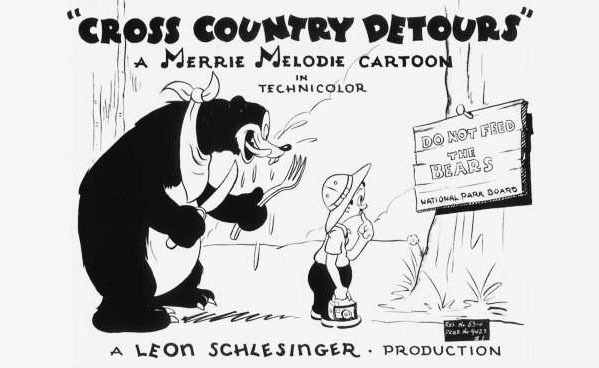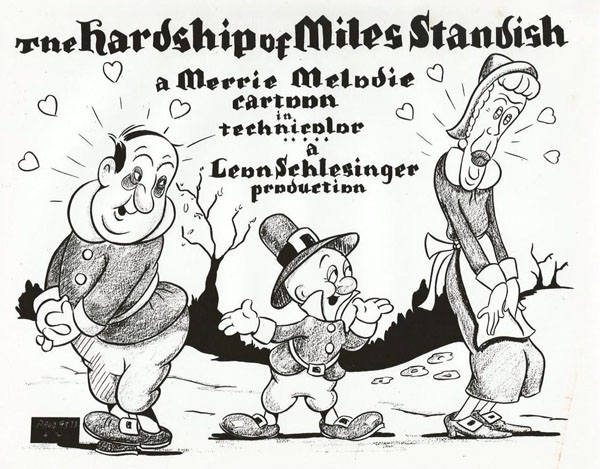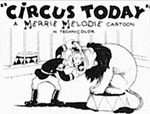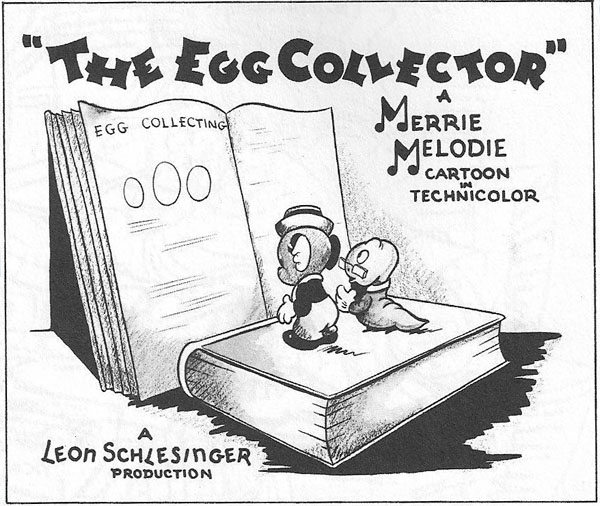The remainder of the 1939-40 Merrie Melodies include titles that crystalize the personalities of two of Warner’s top characters. These characters would stand Warner’s in good stead for the next 20 years, and cement the importance of Mel Blanc and Athur Q. Bryan in the Termite Terrace scheme of things.

Cross Country Detours (3/16/40) A classic Tex Avery spot gag travelogue spoof that takes place all over the US. Includes over two dozen cues ranging from “California Here I Come”, “Oh Bury Me Not On The Lone Prairie” to, most significantly, Stallings first use of “It Had To Be You”, the 1924 tune by Isham Jones and Gus Kahn.

Confederate Honey (3/30/40) – “Gone With the Wind” gets the Termite Terrace treatment, with Arthur Q. Bryan getting again to demonstrate his Elmer Fudd lisp (which at the time seemed to be prevalent in a certain stratum of Manhattan society, and was also associated with actress Kay Francis). Ned Cutler (Elmer) goes through the war between the states, and comes home to try to woo his light of love, Crimson o’ Hair-Oil. He is spurned, however, when Crimson discovers all he really wants is to get his parking ticket validated for the last five years. Songs: “Old Black Joe”, “Are You From Dixie?”, “My Old Kentucky Home”, “Am I Blue”, “Beautiful Dreamer” (as leitmotif for Crimson), Von Suppe’s “Light Cavalry Overture”, “Dixie”, and “Rally Round the Flag, Boys”.
The Bear’s Tale (4/13/40) – The tale of Goldilocks winds up mashed up with Little Red Riding Hood, in a fairy tale spoof that is delivered in the style of Tom McNaughton’s famous monologue, “The Three Trees”, which he recorded for Victor accoustically and which was later remade electrically by Frank Crumit. Warner’s first formative “Three Bears” cartoon, before really developing the characters under Chuck Jones. The curtain line again gets past the Hayes Office – “…with the little bear behind”, as his trousers fall down. Includes one of Avery’s trademark asides to the audience by Papa Bear, as he lets us in on his knowing already how the story ends – because he “read it in Reader’s Digest“. Songs, mostly presented in snatches, but recognizable ones, include “For He’s a Jolly Good Fellow”, Mendelssohn’s Spring Song, “Long Long Ago”, “Home Sweet Home”, “What’s the Matter With Father?” (a song which sounds as if it could have originated in a British music hall, recorded in 1910 by Billy Murray for Victor, and Fred Duprez for Indestructible Cylinders), “That Wonderful Mother Of Mine” (recorded in 1918 for both Victor and Columbia by Henry Burr, Will Oakland on Edison, and much later revived by Phil Regan on Decca and Eddy Arnold on Victor), “Rock a Bye Baby”. “Put On Your Old Gray Bonnet”, “A Tisket, a Tasket”, and “My Old Kentucky Home”.
\

The Hardship of Miles Standish (4/27/40) – Elmer again, this time as proprietor of the “John Alden Messenger Service”, delivering mash notes for Miles Standish in colonial Plymouth colony. May be one of the first cartoons to make a joke about the Cleveland Indians. Narration is provided by a grandpaw character who mimics “the old timer” character created by Bill Thompson for radio’s Fibber McGee and Molly (“That ain’t the way I heard it!”) Songs: “You Must Have Been a Beautiful Baby” (delivered in full verse by Elmer as a singing telegram, with punctuation marks, yet), “Drink To Me Only With Thine Eyes”, “Pizzicato from Sylvia”, “Comin’ Thru the Rye”, and Stalling’s usual Indian riffs.
Sniffles Takes a Trip (5/12/40) – Sniffles takes an outdoor journey (with bindle stick), and finds that everywhere he hangs his hammock, no rest is available. At night, spooky shadows send him scampering home. Regarded as one of the more boring Warner cartoons of the time (though I’d call “Good Night Elmer” a runner-up). It was released for no good reason as a home movie print in 8mm, and must have seemed even more pokey projected at 18 frames per second! The only notable song seems to be called “Oh Boy, I’m On My Way” (likely a studio original, sung by Sniffles). Among the sleepy classical pieces heard in the background is Mendelssohn’s “Consolation”…
A Gander at Mother Goose (5/27/40) – Fairy tales get the treatment again, in another spot gag cartoon. Mother Goose receives screen credit as Technical Advisor. Jack and Jill, for example, never come down the hill – Jack is too busy with a private smooching party up yonder. Songs: “The Old Oaken Bucket” (an oldie recorded by the Haydn Quartet in 1905 or thereabouts for Victor), “Sing a Song Of Sixpence” (in a swing arrangement), “Memories”, a song from about 1915; “Pretty Baby”, “In an Old Dutch Garden”, “Humpty Dumpty”; “Little Brown Jug”, and “Silent Night”.

Tom Thumb in Trouble (6/8/40) – Tom Thumb is, as you’d expect, the minuscule son of a large man. Papa goes out to work, and Tom gets in trouble around the house, nearly drowning in the dishwashing sink. A small bluebird crashes through the window and saves his life, but Papa returns and gets the wrong idea, assuming the bird was an attacker. Tom strikes out at night in a winter storm to try to set the misunderstanding right – and is rescued by the bird again, which finally is recognized by Papa as a hero. The short ends with the family asleep, and the bird making a comfortable nest In Papa’s whiskers. As close as Chuck Jones ever got to producing a Disney-worthy short. Songs inlude “Traumerei” and “Brahm’s Lullaby”, and an original lyric for Tom, sung during the dishwashing scene. The cue sheet lists that tune as “In A Little Dutch Garden” – Here is that track (Thanks, Chris Mulwee):
 Circus Today (6/22/40) – Spot gags under the big top, including references to “Captain Clampett”, the human cannonball, and to effects animator A. C. Gamer as “Gamer the Glutton”, a sideshow freak who eats anything. Not all of the acts come off well – one of the Flying Cadenzas needs to be replaced, and Count Morris Leapold misses the tank of water in his death defying leap, resulting in a trumpet solo from the circus band – of “Taps”! Songs and music include Sousa’s “Sabre and Spurs”, “Vision of Salome”, “Over the Waves”, and “Taps (Last Post).’
Circus Today (6/22/40) – Spot gags under the big top, including references to “Captain Clampett”, the human cannonball, and to effects animator A. C. Gamer as “Gamer the Glutton”, a sideshow freak who eats anything. Not all of the acts come off well – one of the Flying Cadenzas needs to be replaced, and Count Morris Leapold misses the tank of water in his death defying leap, resulting in a trumpet solo from the circus band – of “Taps”! Songs and music include Sousa’s “Sabre and Spurs”, “Vision of Salome”, “Over the Waves”, and “Taps (Last Post).’
Little Blabbermouse (7/6/40) – W.C. Fieldmouse conducts a tour of a drugstore for mice, using the store’s conveyance baskets as a passenger vehicle for his customers. Fieldmouse is pestered by the title character, a tyke who won’t even “shut up shuttin’ up.” Score includes “Strolling Through the Park”, a genuine Gay ‘90’s song;’ “Start the Day Right”; “I’d Love To Take Orders From You”; “You’re the Cure For What Ails Me”; “Half of Me”; “I’m Just Wild About Harry”; “It Looks Like a Big Night Tonight”; “Shake Your Powder Puff”; and “How Do You Do” (theme song of Billy Jones and Ernest Hare).

The Egg Collector (7/20/40) – Recently reviewed in the “Happy Henfruit” articles on Animation Trails series on this website, this is another of those sleepy Chuck Jones vehicles for Sniffles and the Bookworm, highly derivative of “Little Brother Rat”. Only original score here – combined with classical themes by Schubert, Wagner Chopin, and Mendelssohn.

A Wild Hare (8/6/40) – A milestone date in Warner history, as Bugs Bunny comes into his own, crystallizing both the “wascally Wabbit” and the “Scwewy” hunter Elmer Fudd. Codifying many of the tropes to be used time and again in the hunrtng cartoons of the series, including Bugs’ smacking kisses and death scene monologue. Songs: “I’m Just Wild About Harry”, the first use of this Eubie Blake classic in a Warner cartoon, introduced in the show, “Shufflin’ Along”, an all black musical, in 1921. It was recorded by Bennie Krueger’s Orchestra on Brunswick, with a vocal version on the same label by Marion Harris, Ray Miller on Columbia, Ernest Hussar on Pathe Actuelle, Vaughn De Leath (vocal) on Gennett, Vincent Lopez on Edison, Lanin’s Southern Serenaders (the Original Memphis Five augmented) on Banner, and Paul Whiteman on Victor, with later revivals by the Hoosier Hot Shots on ARC labels. Ruby Newman on Decca, Red Nichols with Jimmy Dorsey triple-tonguing on saxophone on Brunswick, Noble Sissle on Variety with Sidney Bechet on sax, Horace Heidt on Columbia, Bud Freeman on Majestic, Al Jolson on Decca, Judy Garland on Decca, and Hoagy Carmichael on Coral, and in England by F. W. Ramsey on Regal, Jimmy Dorsey on British Decca during a 1930 visit with Spike Hughes and his Three Blind Mice, Harry Roy on Parlophone, and Victor Sylvester on Columbia.
Ghost Wanted (8/16/40) – A “newbie” ghost goes to a haunted house to be mentored (and tormented) by an experienced spirit. (The older ghost’s voice appears to be provided by Tex Avery, with that same big laugh used in “The Penguin Parade”, and “Hamateur Night”). All original score, with no song drop-ins.
Ceiling Hero (8/30/40) – Spot gags on aviation, with no plot to speak of, excepting a climactic sequence lampooning “Test Pilot” (indicated on his jacket “from the picture of the same name”). Songs: “Where, Oh Where Has My Little Dog Gone” (accompanying a dogfight), “In My Merry Oldsmobile”. and “My Old Kentucky Home”.
Next: The Looney Tunes of 1940-41.


 James Parten has overcome a congenital visual disability to be acknowledged as an expert on the early history of recorded sound. He has a Broadcasting Certificate (Radio Option) from Los Angeles Valley College, class of 1999. He has also been a fan of animated cartoons since childhood.
James Parten has overcome a congenital visual disability to be acknowledged as an expert on the early history of recorded sound. He has a Broadcasting Certificate (Radio Option) from Los Angeles Valley College, class of 1999. He has also been a fan of animated cartoons since childhood.












































“The Fountain in the Park” (the correct title of “While Strolling Through the Park One Day”) was first published in 1884 and probably written several years earlier, so it’s not really a “genuine Gay ’90’s song”, although I’m sure it remained popular through that decade. It’s been used in many cartoons, such as “The Dover Boys”, and Barney Rubble and a piano salesman played an impressively virtuosic fantasia on that theme in “The Hot Piano”, a first season episode of The Flintstones.
Since, as you noted, “I’m Just Wild About Harry” was used in “Little Blabbermouse” two months before “The Wild Hare”, then “the first use of this Eubie Blake classic in a Warner cartoon” was ipso facto in the former, not the latter.
I’m quite taken with the Frazee sisters. One of them played George O’Hanlon’s wife in the Joe McDoakes comedy shorts.
“Confederate Honey”: Significant because it was the first -released- Friz Freleng cartoon after his return to the studio. Not sure if the acclaimed You Ought to Be in Pictures was started first, though (wouldn’t be surprised if it was, as it probably took more effort to make).
“Ghost Wanted”: No “modern” song cues, but Chopin’s “Prelude, Op. 28, No. 6” plays at 2:21 and 3:50. Speaking of that cartoon, while it still carries early Jones problems, I actually don’t mind it. Part of it is the spooky soundtrack, which I was able to appreciate due to its inclusion in one of the Carl Stalling Project albums.
“Ceiling Hero”: “You, You Darlin'”, which I believe was covered before in this column, also briefly plays.
Note the credits on Confederate Honey indicating Ben Hardaway as writer and Cal Dalton as animator. Possible that H&D started that project, then deferred to Freleng’s experience upon his return to the studio.
There were two similarly titled song used in WB cartoon. The song used in Busy Bakers and A Coy Decoy is IN AN OLD DUTCH GARDEN(BY AN OLD DUTCH MILL)
The song in Tom Thumb in Trouble is called IN A LITTLE DUTCH KINDERGARTEN(BY THE LITLE OLD ZUIDERZEE) which was sung again with the “real” lyrics by Sniffles in The Brave Little Bat.
Hope this helps with the confusion..
Speaking of similar sounding song titles, I always have to remind myself that the aforementioned “The Fountain in the Park” and “Concert in the Park” are two different songs.
Interestingly, “The Fountain in the Park” is one of the few vintage songs that carried over to the various Warner Bros. Animation shows of the ’90s- those series, aside from some exceptions, mostly stuck to public domain ditties and classical music cues (I assume due to not having access to the song rights as much as Stalling did in the late ’30s-early ’50s).
In “Bear’s Tale,” isn’t Little Red Riding Hood introduced with “The Lady in Red”?
You missed one music cue in “TOM THUMB IN TROUBLE”; a specific known classical piece is played as Tom’s father ventures out in the whirling snowstorm to look for Tom, with a nice visual job done on the animation of the snow blowing all around him. I was trying, as a matter of fact, to recall whether or not the piece is played in any other cartoon, but I don’t think it even appears again in “WHAT’S OPERA DOC”. Anyone know exactly what the title of that piece is? I dont’ want to get the spelling of the title wrong, so I don’t even want to guess…also, I admit that I like “SNIFFLES TAKES A TRIP” more than anyone on this forum. It is a subtle cartoon, full of great visuals, like Sniffles accidentally tying his hammock onto the legs of a crane. I always liked the scene as the bird walks along with Sniffles just lying in the hammock, unaware at first that he’s moving. The bird steps slowly into the lake, and Sniffles sleeps peacefully underwater…another has Sniffles suddenly thinking that he’s face to face with the hungry eyes of an alligator, only to find that it is a croaking frog as the critter emerges onto land, and Carl Stalling’s music guiding every scene and mood change throughout the cartoon until that nighttime sequence as Sniffles turns with a start at every bird call or shuffling noise throughout the forest, seeing eyes peering at him from treetops or other habitats. Jones wasn’t just trying to be Disney here; at least, I don’t think so.
Kevin, that piece is Wagner’s “Ride of the Valkyries”. It is indeed heard, briefly, in “What’s Opera, Doc?” (as “Kill the wabbit!”), and at greater length in the Disney Silly Symphony “Music Land”. Also, the music heard at the beginning of “Tom Thumb in Trouble” is the Johann Strauss waltz “Wiener Blut”.
Souza’s Sabre and Spurs was also on the soundtrack for HAREDEVIL HARE – The first MARVIN THE MARTIAN cartoon.